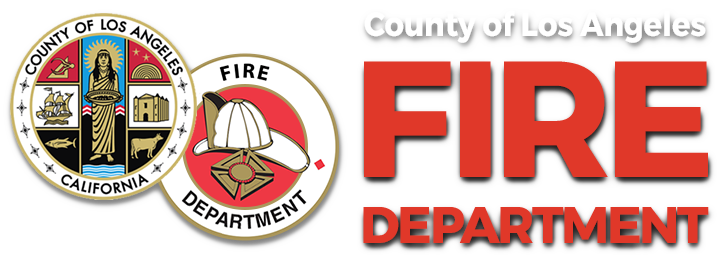LACoFD and Supervisor Barger Host Media Day for SuperScoopers’ Arrival
On Friday, September 6, 2019, Los Angeles County Fifth District Supervisor Kathryn Barger, Fire Chief Daryl L. Osby and Québec…
read more
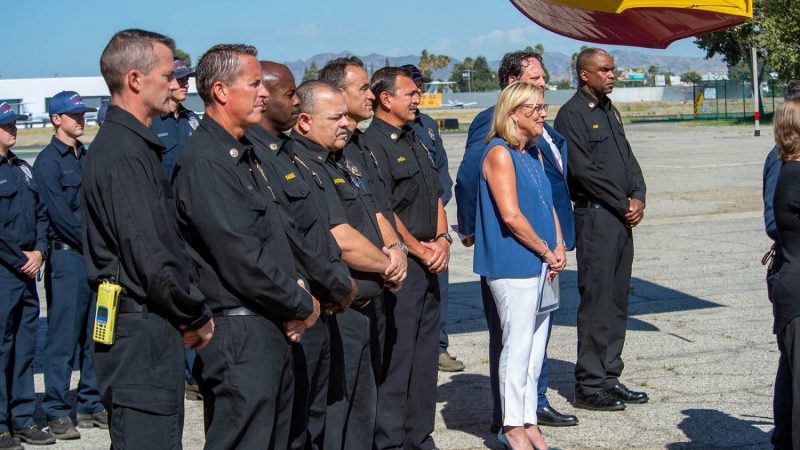
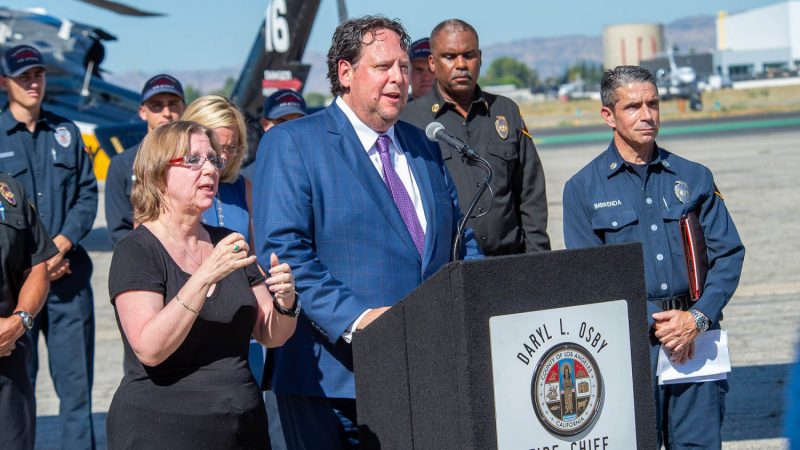
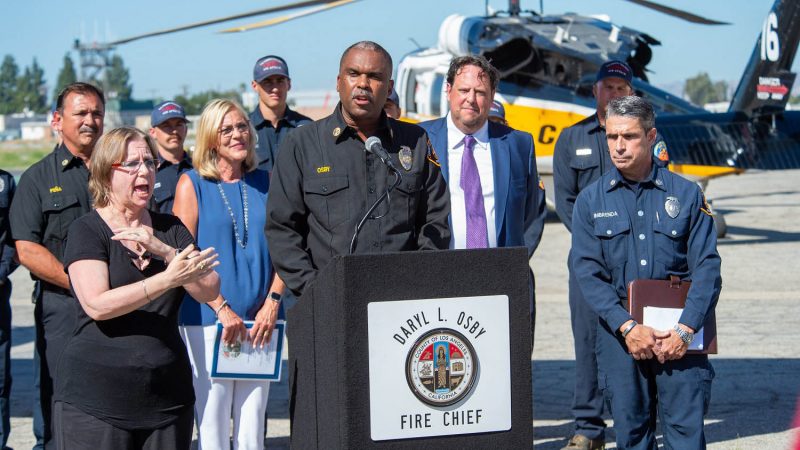
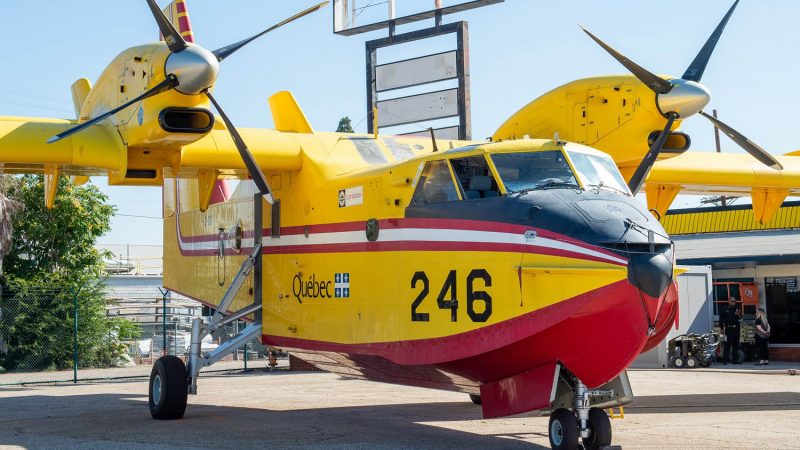
On Friday, September 6, 2019, Los Angeles County Fifth District Supervisor Kathryn Barger, Fire Chief Daryl L. Osby and Québec…
read more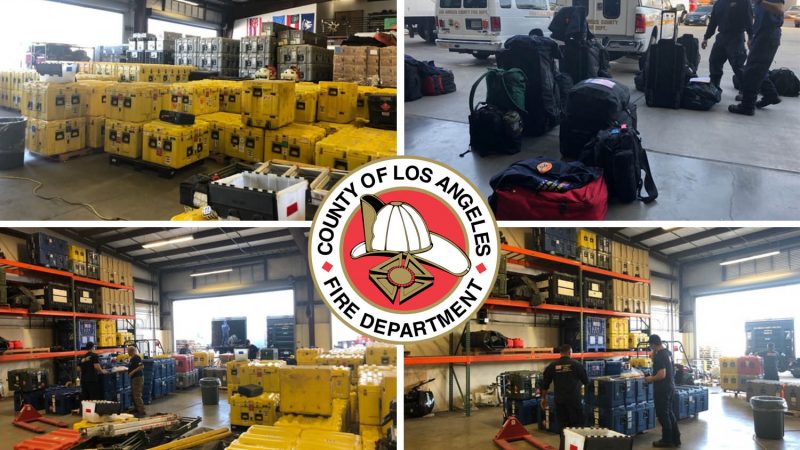
In response to the catastrophic Hurricane Dorian, highly skilled Los Angeles County Fire Department (LACoFD) Urban Search and Rescue (USAR)…
read more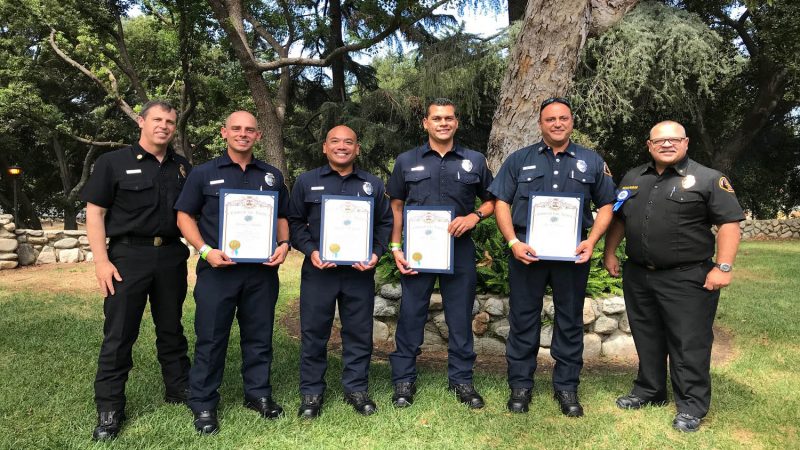
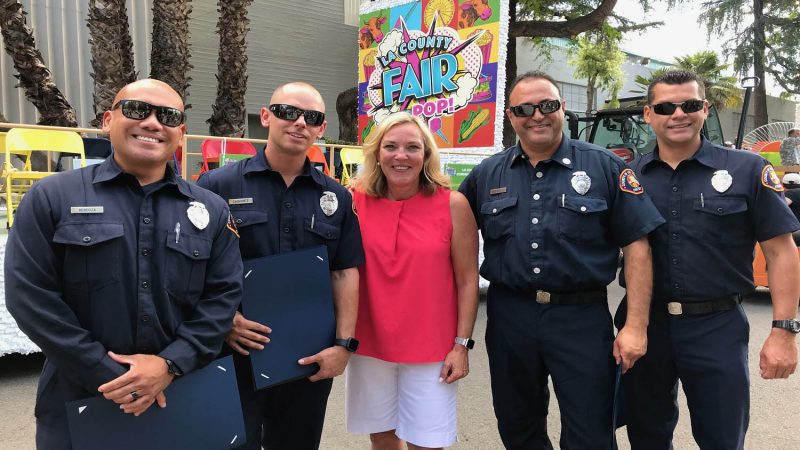
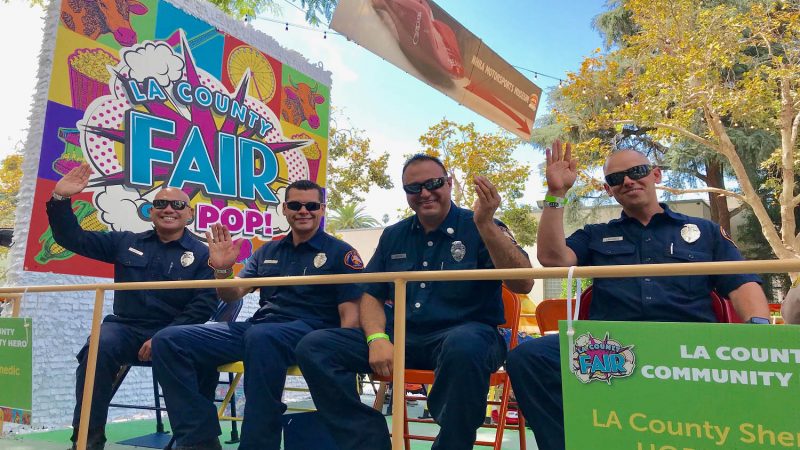
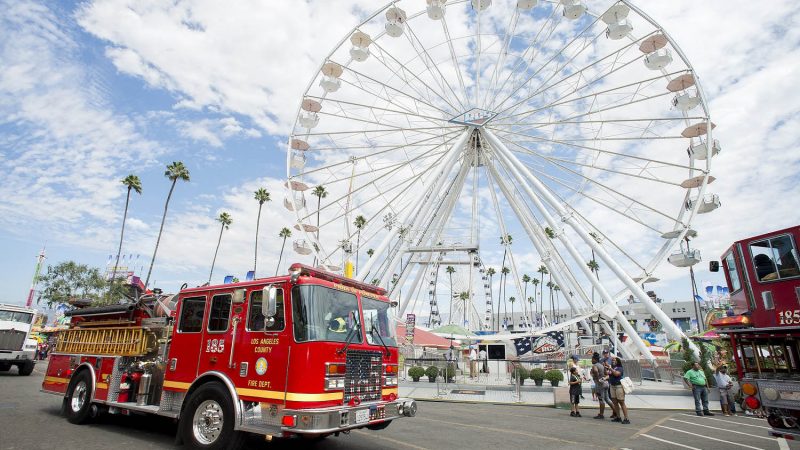
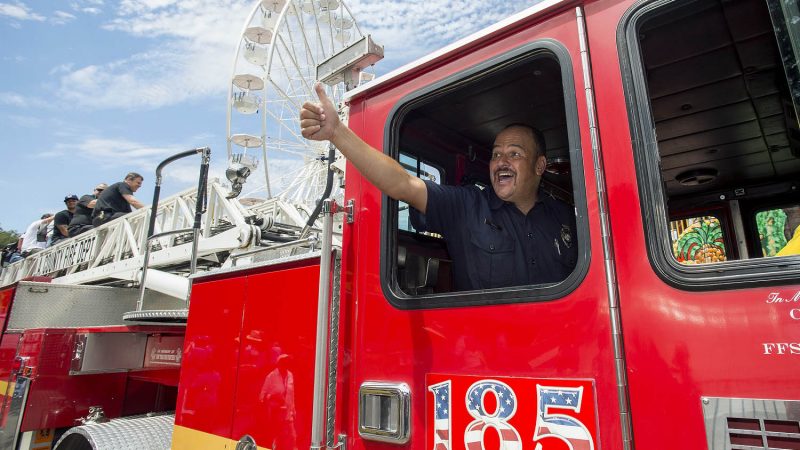

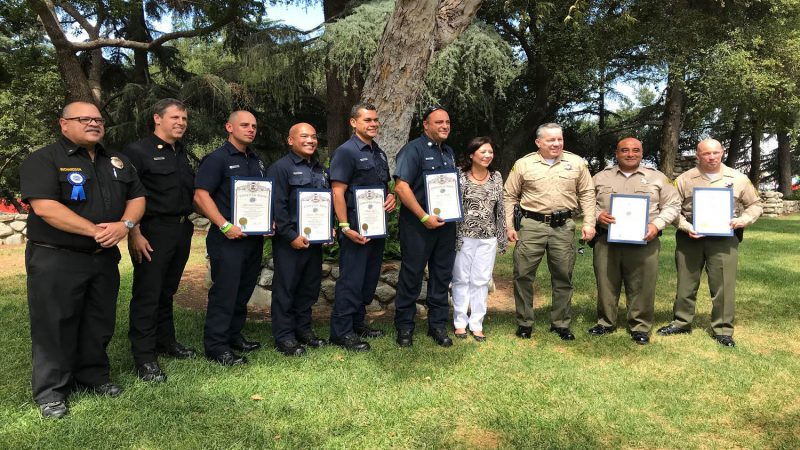
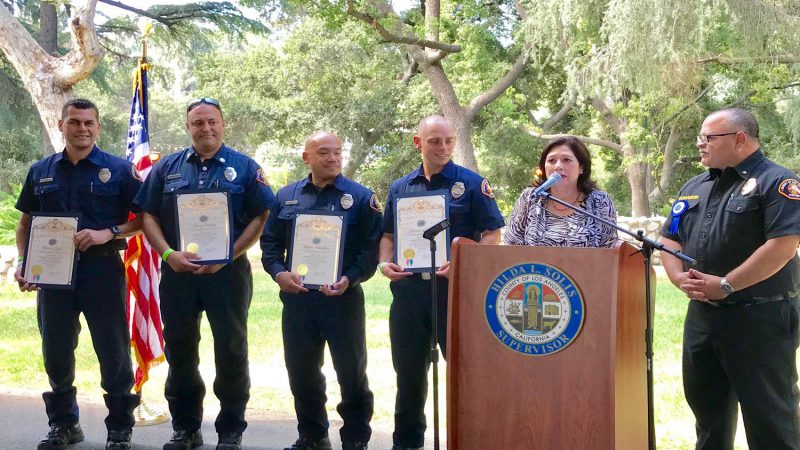
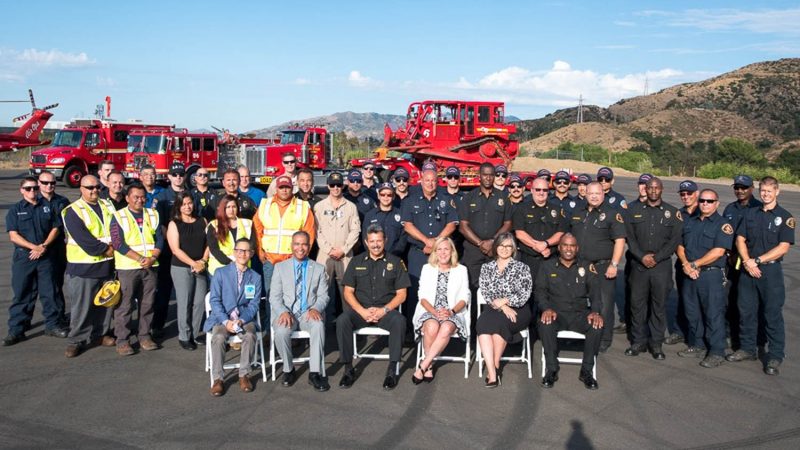
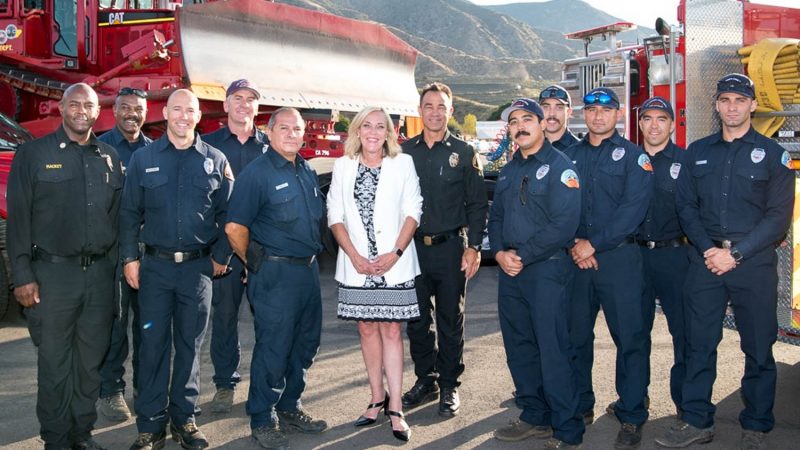
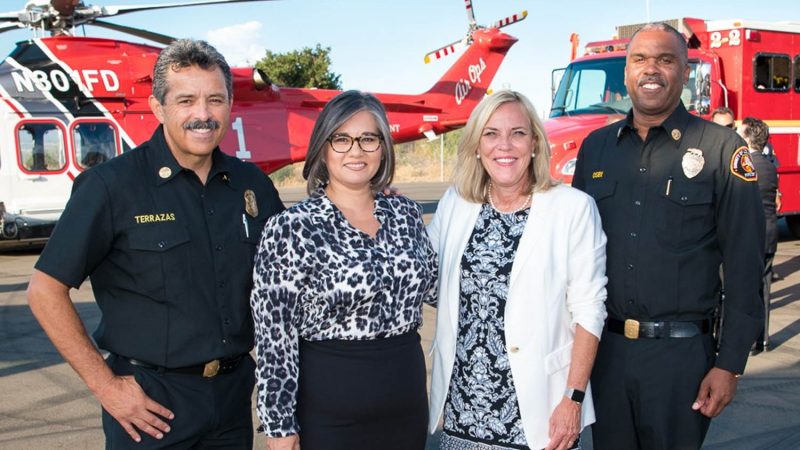
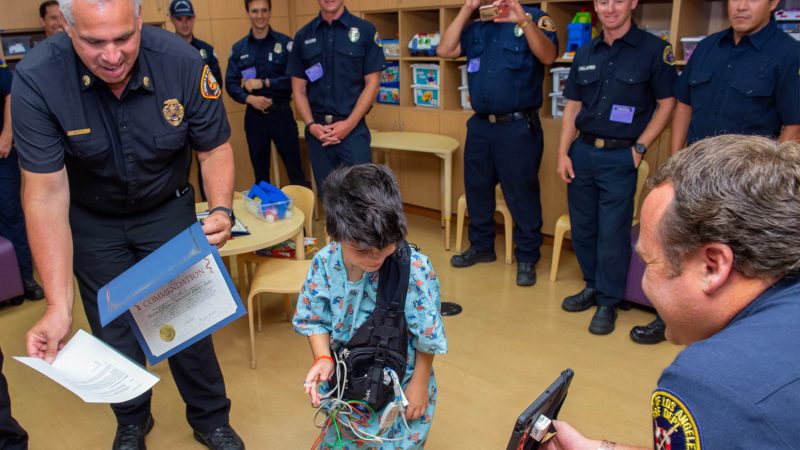
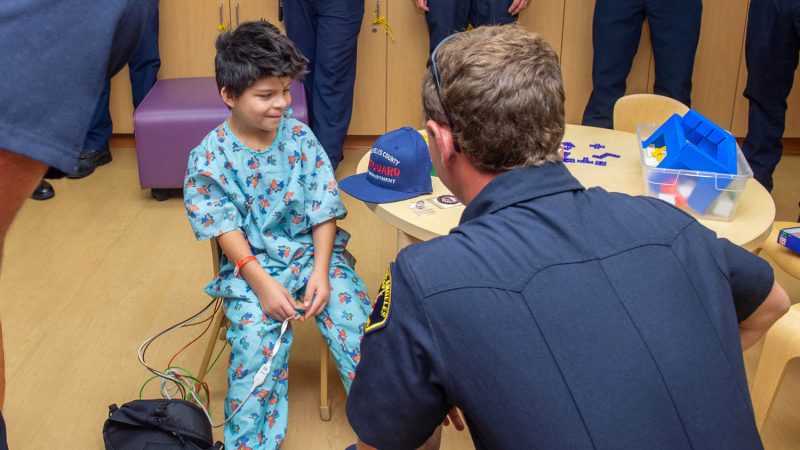
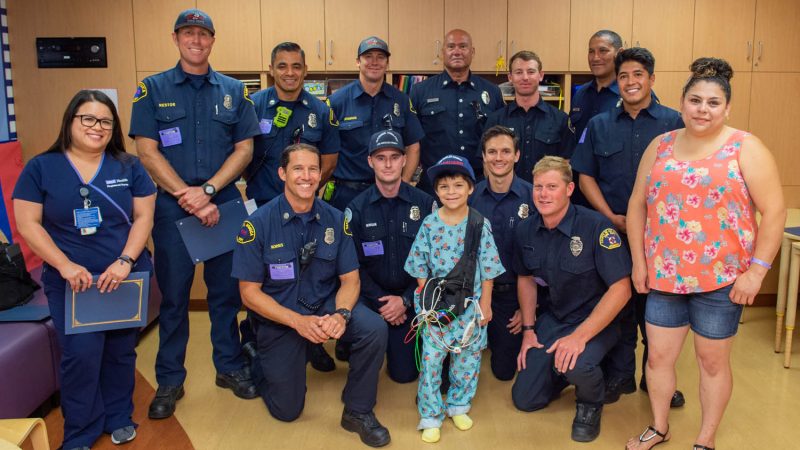

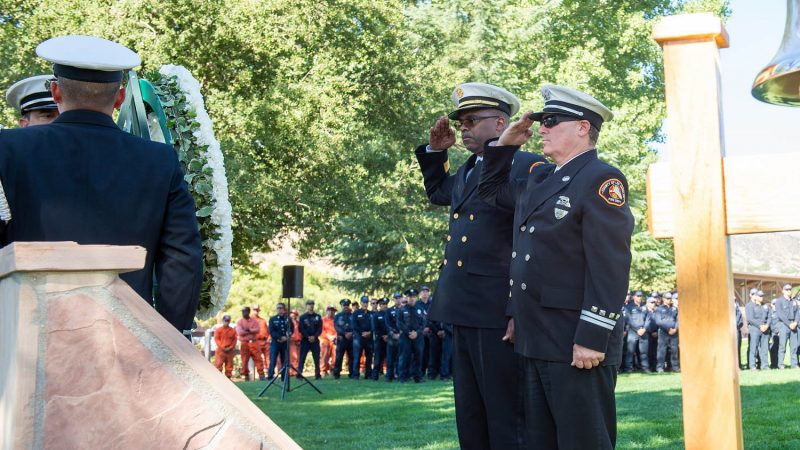
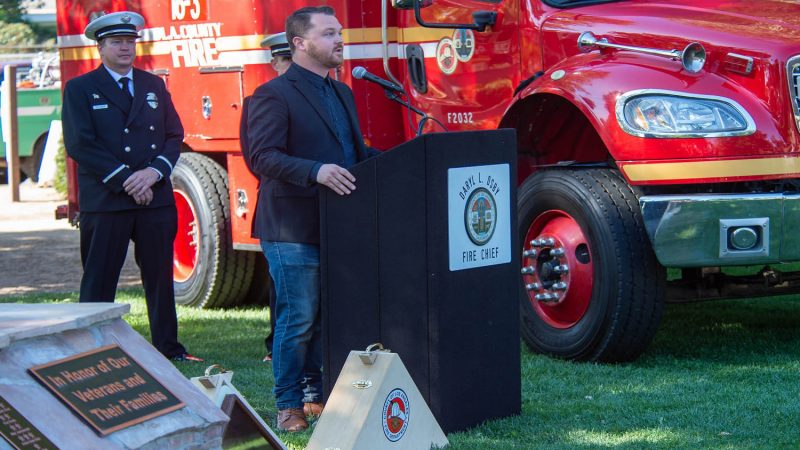
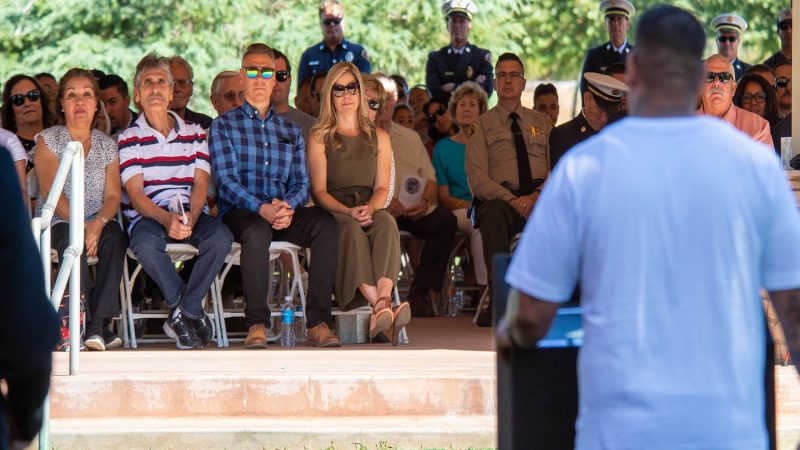
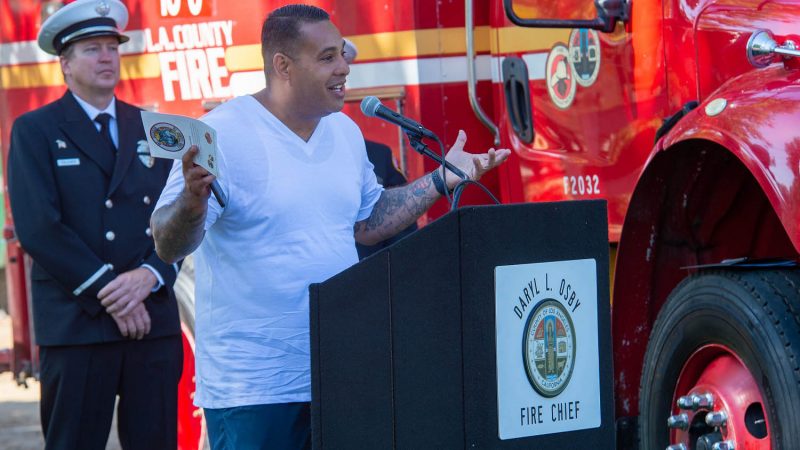

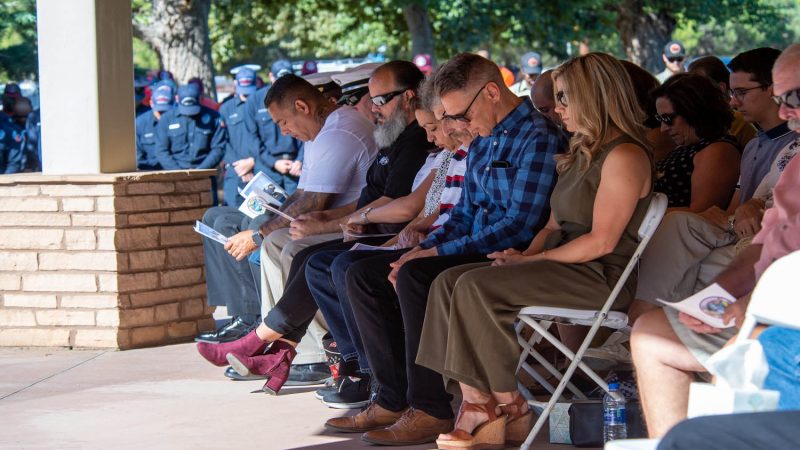
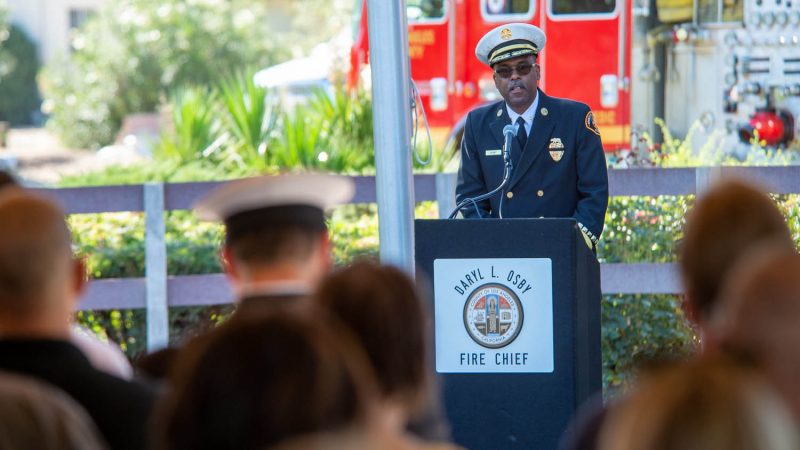
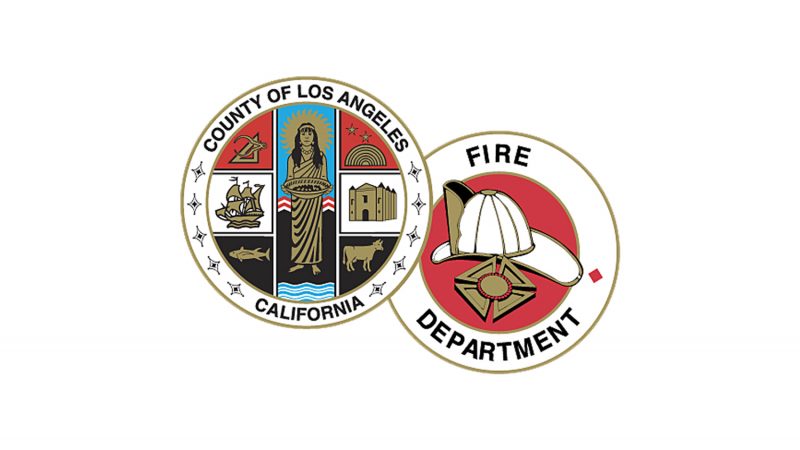


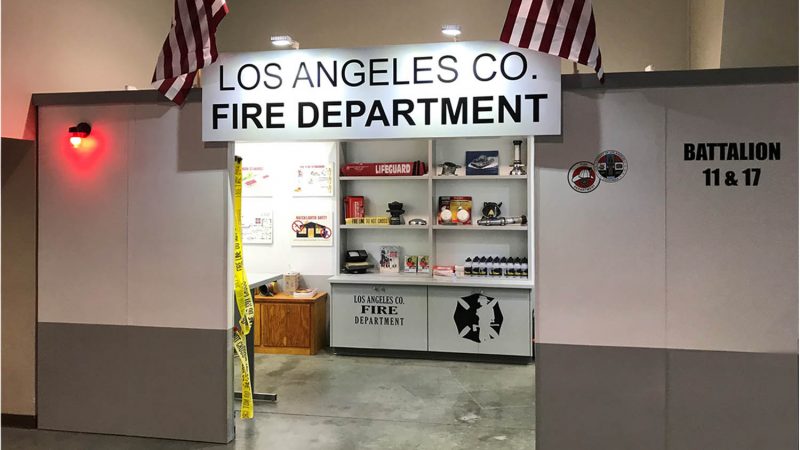
Born to immigrant parents who moved to the United States from Greece, Deputy Fire Chief Eleni Pappas was raised in Jersey City, New Jersey. After graduating from Saint Dominic’s Academy High School, she was accepted into the University of Southern California where she competed as a varsity rower, helping her team win the prestigious San Diego Crew Cup. She graduated with a bachelor’s degree during the civil unrest in May 1992.
From her college apartment, she watched Los Angeles burn and was impressed with the fire engines and tiller trucks racing across the city to extinguish the fires. She decided then and there to become a firefighter.
By 1996, Chief Pappas earned her paramedic license from Daniel Freeman Paramedic School in Inglewood. She then worked as an EMT for Goodhew Ambulance where she ran 9-1-1 calls with the Los Angeles County Fire Department (LACoFD).
A few years later, she was hired by Ventura County Fire Department and served as a firefighter for one year. She then became a firefighter with the City of Los Angeles and served there for four years. In 2001, after the attack on the World Trade Center, she was accepted into the Department’s Recruit Academy and graduated from the 109th Recruit Class later that year.
Since joining the LACoFD, she has promoted through every rank and is currently the highest-ranking woman in the Department’s history and the first-ever woman to obtain the ranks of Assistant Fire Chief and now Deputy Fire Chief.
She has worked in all three regional operations bureaus and in all 22 operations battalions. Since her promotion as a chief officer in September 2012, Chief Pappas has spent three years as the co-chairperson of the Equipment Development Committee and also managed the Department-wide implementation of the electronic patient care reporting (ePCR) system. As an Assistant Fire Chief, she was assigned to Division VI in the Central Regional Operations Bureau and managed the Fire Explorers youth mentoring program. Currently, she is assigned to the Special Services Bureau where she manages the Command and Control, Construction and Maintenance, and Fleet Services Divisions.
In August 2021, Chief Pappas successfully completed her master’s degree in Emergency Management from Cal State Long Beach.
At home, Chief Pappas enjoys gardening and spending time with her family, their dogs, parakeets, and bearded dragon. Raising her daughter is her greatest accomplishment. She cherishes spending quality time with her beautiful 12-year-old daughter who is the center of her life.
Acting Deputy Fire Chief Mike Inman has worked as a fire service professional for over 39 years. Chief Inman started his career in 1983, as a reserve firefighter with the Monterey Park Fire Department. In 1986, he was hired as a firefighter with the County of Los Angeles Fire Department (LACoFD) and has promoted through the ranks as a firefighter paramedic, firefighter specialist, fire captain, battalion chief, and assistant fire chief.
Currently assigned as the acting deputy fire chief of the East Regional Operations Bureau (EROB), Chief Inman leads 1,400 personnel across four divisions that include ten battalions and 76 fire stations serving 33 cities. He also oversees the LACoFD’s Equipment Development Committee. Previous assignments include managing the EROB’s Division 2 as the assistant fire chief which consisted of two battalions and sixteen fire stations serving nine cities.
Well versed in emergency management, Chief Inman became a pioneer in the Urban Search and Rescue program that included several national deployments. For over 23 years, he has held various incident command system (ICS) positions as part of the United States Forest Service Type 2 Incident Management Team (IMT) and served as the operations section chief and operations branch director with the Cal Fire Type 1 IMT. Since 1998, Chief Inman has served in various capacities on the LACoFD Incident Management Teams.
Chief Inman is a certified California State Fire Marshal Chief Officer, and a graduate of the Executive Leadership Development Program and Public Safety Leadership Program at the University of Southern California, Sol Price School of Public Policy. He teaches FEMA and California Incident Command Certification System (CICCS) courses and is a qualified incident commander, operations section chief, safety officer, and division supervisor.
Over the last several years, Chief Inman has served as the operations section chief for several all-risk and wildland urban interface incidents, including, but not limited to, the Woolsey Fire (2018), Saddle Ridge Fire (2019), Operation Room Key (2020), COVID-19 Mass Vaccinations (2021), and Super Bowl LVI (2022).
Deputy Fire Chief Dennis Breshears started his fire service career at the age of 23 after he was appointed to the Monrovia Fire Department on February 24, 1994.
Chief Breshears then moved to the Orange County Fire Authority in 1999 and began his service with the Los Angeles County Fire Department (LACoFD) in December 2000. He has steadily promoted through the ranks from Fire Fighter, Fire Firefighter Paramedic, Fire Fighter Specialist, Captain, Battalion Chief, Assistant Fire Chief, and now to Deputy Fire Chief on December 16, 2021.
Over the years, Chief Breshears attended Lutheran High School (La Verne, California), Glendale College, Cal Poly San Luis Obispo, Kaplan University, and California State University, Long Beach. He holds a bachelor’s degree in Fire and Emergency Management and a master’s degree in Emergency Services Administration.
For more than three years, Chief Breshears served as the Chief of the Professional Performance Section. As a captain, he also completed a special assignment as the Department ICS Coordinator. Chief Breshears is a state-certified instructor and Type II Operations Section Chief and Deputy Incident Commander for LAC IMT 1.
In June 2021, Chief Breshears was selected to serve on the FIRESCOPE Task Force. He is currently assigned as the Deputy Fire Chief over the Leadership and Professional Standards Bureau.
In his spare time, he enjoys spending time with his family and restoring classic cars. While he is very proud of his profession, he considers being a father to three amazing daughters as his greatest accomplishment in life.
In her role as Chief Deputy of Business Operations, Theresa Barrera oversees the Fire Department’s $1.5 billion budget and provides executive oversight of the Administrative Services, Special Services, and Prevention Services Bureaus.
Chief Barrera joined the Fire Department in 2004 where she served as the Assistant Chief and Chief of the Financial Management Division. In 2022, Chief Barrera was appointed as Deputy Fire Chief of the Administrative Bureau and worked closely with internal and external stakeholders to improve standard business practices, ensure administrative and fiscal compliance, and foster a workforce that is representative of the communities we serve. In August 2023, Chief Barrera was appointed as the Chief Deputy of Business Operations.
Prior to joining the Fire Department, Chief Barrera devoted 16 years climbing the ranks in administrative services at the Los Angeles County Department of Public Social Services and Auditor-Controller. Chief Barrera received her Bachelor of Science degree in Accounting from the University of Southern California. She is a Board Member for the F&A Federal Credit Union.
Chief Deputy Jon F. O’Brien has worked as a fire service professional for over 33 years. Chief O’Brien started his career as a volunteer firefighter with the City of Sierra Madre. After graduating from high school, he completed paramedic training at the Los Angeles County Paramedic Training Institute and was hired by the City of Monrovia as a full-time firefighter/paramedic until he joined the County of Los Angeles in 1999.
Chief O’Brien has served in several operational and administrative assignments, promoting through the ranks to his current position as Chief Deputy of Emergency Operations. Along the way, he has worked as a flight medic in the Department’s Air Operations Section, a fire crew supervisor in the Camps Section, a recruit training captain, and a field battalion chief.
In April 2014, Chief O’Brien was assigned to the Emergency Medical Services (EMS) Bureau and was responsible for the education and training of the Department’s 3,200 emergency medical technicians and 1,250 paramedics. The following year in November 2015, Chief O’Brien was promoted to Assistant Fire Chief and assigned to Division VI in the Central Regional Operations Bureau. In July 2017, he returned to the EMS Bureau as Acting Deputy Fire Chief and was officially promoted to Deputy Fire Chief in December 2017.
In April 2020, Chief O’Brien was assigned as Deputy Fire Chief of the North Regional Operations Bureau where he oversaw the cities of Palmdale, Lancaster, Santa Clarita, and La Cañada Flintridge, as well as the Air & Wildland Division and the Technical Operations Section. He was also the incident commander of the Department’s Incident Management Team 1.
In October 2022, Chief O’Brien assumed the role of Acting Chief Deputy of Emergency Operations. As Chief Deputy, Chief O’Brien serves as second in command and is responsible for overseeing the Fire Department’s three Operations bureaus (North, Central, and East), as well as the Air and Wildland Division and the Lifeguard Division. Chief O’Brien is also responsible for the Training and Emergency Medical Services Bureau and the Homeland Security Section.
On August 23, 2023, was officially assigned as Chief Deputy of Emergency Operations.
Chief O’Brien received his Associate of Arts degree in fire science at Mount San Antonio Community College and his Bachelor of Science degree in public policy and management at the University of Southern California. He currently represents the Department on the FIRESCOPE Operations Team and the Los Angeles County Measure B Advisory Committee.
Julia Kim began her employment with the County of Los Angeles in January 2015, and has served in the Professional Performance Section, Employee Relations Division, Risk Management Division, and most recently, the Human Resources Division.
Chief Kim was appointed to Deputy Fire Chief in September 2023.
Fire Chief Anthony C. Marrone has been a chief officer for the past 25 years and a member of the County of Los Angeles Fire Department for 37 years. Prior to his executive appointment by the County of Los Angeles Board of Supervisors, Deputy Fire Chief Marrone recently served as Acting Chief Deputy over Business Operations and as Interim Fire Chief.
Chief Marrone leads one of the largest metropolitan emergency services agencies in the United States, providing traditional fire and life safety services to more than 4.1 million residents and commercial business customers in 60 cities served by the Department, in addition to all the unincorporated areas of Los Angeles County within its 2,311-square-mile service delivery area. The Department operates out of 177 fire stations, with 4,900 emergency responders and business professionals operating with an annual budget of just under $1.6 billion. In addition, the Department provides lifeguard, air and wildland, health hazardous materials, and forestry services throughout the County.
Chief Marrone’s well-established career combines broad experience in both emergency and business operations with an extensive list of accomplishments and assignments, including leading and managing the Leadership and Professional Standards Bureau, Special Services Bureau, Emergency Medical Services Bureau, East Regional Operations Bureau, and Central Regional Operations Bureau, in addition to special projects and Business Operations. He has also directly managed routine and complex wildland fires and other significant all-risk incidents.
During his career with the Department, Chief Marrone has served on the Los Angeles County Emergency Preparedness Commission, the FIRESCOPE Task Force, Legal Exposure Reduction Committee, County Emergency Operations Center, and as an Incident Commander on one of the Department’s three Incident Management Teams.
Chief Marrone looks forward to collaborating with the Board of Supervisors, labor unions, stakeholder organizations, members of the Department, and the residents and communities we serve, to further enhance the delivery and quality of emergency and life safety services to those in our care, while working together to increase our diversity, equity, and inclusion.
Acting Deputy Fire Chief William L. Mayfield Jr. is a 34-year veteran of the County of Los Angeles Fire Department. He began his fire service career in 1988. He has held the ranks of Fire Fighter, Fire Fighter Specialist, Fire Captain, Battalion Chief, and Assistant Fire Chief.
His previous assignment includes managing Division IV of the East Regional Operations Bureau, consisting of three battalions, 12 cities and 25 fire stations. Chief Mayfield has been a chief officer for over 17 years. He has worked multiple operational, administrative, and special assignments throughout his career, including fire prevention, command and control, and several field commands.
As of October 2022, Chief Mayfield’s new assignment is to command and lead the Central Regional Operations Bureau. In this role, he provides leadership for four divisions, seven battalions, 55 fire stations within 22 cities, and over 1,600 firefighting and lifeguard personnel. The Lifeguard Division provides water rescue and medical services to 11 cities and consists of specialized and trained professionals who protect Catalina Island and 72 miles of sandy beaches and open water.
As an Incident Commander, Chief Mayfield also manages the Department’s Incident Management Team 2.
Carson
701 E Carson St., Rm B-24
Carson, CA 90745
(310) 830-9596
East Los Angeles
4801 E Third St.
Los Angeles, CA 90022
(323) 881-7068
Hawthorne
4475 W El Segundo Blvd.
Hawthorne, CA 90250
(310) 263-2732
Lynwood
3161 Imperial Hwy.
Lynwood, CA 90262
(310) 603-5258
West Hollywood
864 N San Vicente Blvd.
West Hollywood, CA 90069
(310) 358-2380
LAND DEVELOPMENT UNIT
5823 Rickenbacker Road
Commerce, CA 90040
(323) 890-4243
CODES AND ORDINANCES UNIT
5823 Rickenbacker Road
Commerce, CA 90040
(323) 890-4226
PREVENTION DATA SYSTEMS UNIT
5823 Rickenbacker Road
Commerce, CA 90040
(323) 890-4340
HIGH RISE/COUNTY FACILITIES UNIT
590 S. Park Street
Pomona, CA 91766
(909) 620-8327
Arcadia
125 S. Baldwin Ave
Arcadia, CA 91006
(626) 574-0963
Cerritos
19030 Pioneer Blvd
Cerritos, CA 90703
(562) 860-8014
Irwindale
5200 Irwindale Ave
Irwindale, CA 91706
(626) 430-3050
Azusa
605 N. Angeleno Ave
Azusa, CA 91702
(626) 969-7876
Glendora
231 W. Mountain View Ave
Glendora, CA 91741
(626) 963-0067
Diamond Bar
1061 S. Grand Ave
Diamond Bar, CA 91765
(909) 620-2216
La Habra
850 W. La Habra Blvd
La Habra, CA 90633
(562) 691-9369
Commerce
2535 Commerce Way
Commerce, CA 90040
(323) 720-9913
PETROLEUM CHEMICAL UNIT
5200 Irwindale Ave
Irwindale, CA 91706
(626)430-3040
HIGH RISE/COUNTY FACILITIES UNIT
590 S. Park Street
Pomona, CA 91766
(909) 620-8327
Deputy Fire Chief Vince A. Peña has been with the Los Angeles County Fire Department since 1981. Chief Peña has held the positions of firefighter, firefighter paramedic, firefighter specialist, fire camp foreman, fire captain, battalion chief, assistant fire chief, deputy fire chief, and acting chief deputy.
As a chief officer, battalion chief assignments have included Battalion 5 in Malibu, Battalion 16 in Covina, Battalion 20 in Inglewood, and Battalion 2 in San Dimas. He also served as the camp section battalion chief for the paid camps and heavy equipment unit. As an assistant fire chief, he was assigned to Division 2 in the east San Gabriel Valley and the Air & Wildland Division.
In Chief Peña’s assignment as the deputy fire chief of the North Regional Operations Bureau, he oversaw the cities of Palmdale, Lancaster, Santa Clarita, and La Cañada Flintridge, as well as the Technical Operations Section and the Air & Wildland Division. He has also served as operations section chief for the Department on many large wildland incidents and was the incident commander of the Department’s Incident Management Team 1.
Since October 2022, and following his assignment as acting chief deputy, Chief Peña has served as the deputy fire chief over the East Regional Operations Bureau.
Chief Peña attended East Los Angeles College, the University of La Verne, and the Executive Leadership Development Program for the County of Los Angeles. He also instructs incident command courses for the Fire Department and throughout the country.
Deputy Fire Chief Thomas C. Ewald has served in the professional fire services for 35 years. Chief Ewald started his career as a firefighter with the City of Cedar Rapids, Iowa Fire Department in 1986. While working in the Midwest, he attended community college and completed paramedic training. Chief Ewald joined the Los Angeles County Fire Department in 1992 where he rose through the ranks serving as firefighter, paramedic, captain, battalion chief, and assistant chief.
Chief Ewald has served as a firefighter paramedic at Universal Studios and West Hollywood; a fire inspector in East Los Angeles; an apparatus engineer in Carson and Pomona; an engine company captain in Southgate and South Los Angeles; a staff captain for the Central Regional Operations Bureau Deputy; a field battalion chief in El Monte, Commerce, Palos Verdes; the chief of Technical Operations, overseeing local, national and international Urban Search and Rescue Operations; assistant chief in Division I, covering the South Bay and Catalina Island, and as the assistant chief, overseeing the Air and Wildland Division.
During his career, Chief Ewald has been called upon to respond to manmade and natural disasters across the county and worldwide with notable incidents, including Hurricane Katrina (New Orleans), Hurricane Dean (Belize), Cyclone Nargis (Camp H.S. Smith Hawaii), 2011 Japan Earthquake and Tsunami (Ofunato) , 2011 New Zealand Earthquake (Christchurch) and 2015 Typhoon Maysak (Micronesia).
In December 2017, Chief Ewald was promoted to the rank of Deputy Fire Chief where he oversaw the Department’s Special Services Bureau consisting of three divisions: Fleet Services, Command and Control, and Construction & Maintenance.
On April 1, 2021, Chief Ewald’s tour of duty ended at Special Services and he assumed command of the Central Regional Operations Bureau. By October 2022, Chief Ewald was then assigned to oversee the North Regional Operations Bureau.
Chief Ewald holds a Bachelor of Science degree in Fire Prevention Administration from Cogswell Polytechnical College and a Master of Science degree in Leadership from the University of Southern California’s Sol Price School of Public Policy. In 2018, Chief Ewald attended the Senior Executives in State and Local Government Program at Harvard University’s Kennedy School of Government. Chief Ewald is a qualified Type 2 Incident Commander and Type 2 Operation Section Chief and provides leadership to the Department’s Incident Management Team Two.
Chief Ewald resides in Southern California with his wife and four children.
Acting Deputy Fire Chief Robert Harris started his career at the age of 19 after he was appointed reserve firefighter with the City of Montebello Fire Department.
Chief Harris began his service with the Los Angeles County Fire Department on May 8, 1992. During his tenure with the Department, he has promoted through the ranks from Firefighter, Fire Fighter Paramedic, Fire Inspector, Fire Fighter Specialist, Fire Captain, Battalion Chief, Assistant Fire Chief, and Acting Deputy Fire Chief, effective September 1, 2022.
Over the years, Chief Harris has attended Dillard University (New Orleans), the University of Southern California, Long Beach Community College, and Compton Community College. Currently, he is a senior at Columbia Southern University, completing his bachelor’s degree in Fire and Emergency Management.
For more than 28 years, Chief Harris has served as a member of the Department’s international Urban Search and Rescue Team. He has traveled and provided rescue efforts around the globe. For more than four years, he served as the program manager of our elite rescue team and was the Department’s primary point-of-contact with our state, federal, and international partners.
In his spare time, he enjoys spending time with family and riding motorcycles. Chief Harris has a true passion for mentoring others who are seeking a career in the fire service. He believes in the motto, “each one, reach one”.
Anderson Mackey is an Acting Deputy Fire Chief for the Los Angeles County Fire Department, currently overseeing Training and the Emergency Medical Services Bureau.
Chief Mackey was born and raised in the City of Los Angeles and is a 33-year veteran of the Department. After graduating from the fire academy, he was assigned to Fire Station 103 in Pico Rivera. He was later assigned to Fire Station 105 in Compton as his second probationary station. In November 1989, Fire Fighter Mackey transferred to Fire Station 8 in West Hollywood. In January 1991, he volunteered to attend the Paramedic Training Institute. After successful completion of the six-month program, he was re-assigned to Fire Station 8 as a Fire Fighter Paramedic. In February 1992, he transferred to Fire Station 7 where he remained for the next six years. In October 1998, Mackey transferred to Fire Station 161 in Hawthorne and, 11 months later, was promoted to the rank of Fire Fighter Specialist. He was then re-assigned to Fire Station 58 in Ladera Heights. In February 2000, Mackey promoted to the rank of Fire Captain and was assigned to Fire Station 83 in Rancho Palos Verdes. By November 2000, he transferred to Fire Station 173 in Inglewood. In November 2006, Chief Mackey volunteered to head the Recruitment Unit where he managed over 50 recruiters who volunteered to give career presentations at high schools, colleges/universities, career fairs, and community events. In November 2010, Chief Mackey was promoted to the rank of Battalion Chief and was assigned to Battalion 10 in El Monte, and then Battalion 8 in Whittier. In 2011, he was transferred to Battalion 20 in Inglewood. Two years later, Chief Mackey was re-assigned to the Employee Services Section where he worked directly for the Fire Chief. In February 2018, he promoted to the rank of Assistant Fire Chief.
Chief Mackey received his diploma of completion at Dillard University, New Orleans for the Executive Development Institute. He resides in Pasadena with his beautiful wife Carmen and two lovely daughters, Denver and Blu. In his spare time, he enjoys golf, swimming, skiing, and spending time with his family and friends.
Assistant Fire Chief: 323.586.7049
Community Services Liaison: 323.586.7039
Today, the CFPD serves all of the unincorporated area within Los Angeles County, as well as the following 60 incorporated cities, 59 of which are in Los Angeles County and one in Orange County:
Agoura Hills
Artesia
Azusa
Baldwin Park
Bell
Bellflower
Bell Gardens
Bradbury
Calabasas
Carson
Cerritos
Claremont
Commerce
Covina
Cudahy
Diamond Bar
Duarte
El Monte
Gardena
Glendora
Hawaiian Gardens
Hawthorne
Hermosa Beach
Hidden Hills
Huntington Park
Industry
Irwindale
Inglewood
La Canada Flintridge
La Habra (Orange Co.)
Lakewood
Lancaster
La Mirada
La Puente
Lawndale
Lomita
Lynwood
Malibu
Maywood
Norwalk
Palmdale
Palos Verdes Estates
Paramount
Pico Rivera
Pomona
Rancho Palos Verdes
Rolling Hills
Rolling Hills Estates
Rosemead
San Dimas
Santa Clarita
Signal Hill
South El Monte
South Gate
Temple City
Vernon
Walnut
West Hollywood
Westlake Village
Whittier
Since the passage of Proposition 13, thirteen cities have entered into fee-for-service contracts with the CFPD. These are cities that are annexed to and/or contract with the Fire District for services. The CFPD bills these cities an annual fee for the cost of providing services. Annual fees are based upon the net cost of staffing levels in the city plus overhead. These fees are updated annually based upon current salary, employee benefits, and overhead costs. These fee-for-service cities are as follows:
Azusa
Commerce
Covina
El Monte
Gardena
Hawthorne
Hermosa Beach
Inglewood
La Habra (Orange County)
Lynwood
Palos Verdes Estates
Pomona
Vernon
The CFPD also has contracts with State, Federal, and other agencies that generate revenues, as well as a few fees and charges for various services.
Commonly known as the Los Angeles County Fire Department, the Consolidated Fire Protection District of Los Angeles County (CFPD) is a dependent special district. As a dependent special district, the Los Angeles County Board of Supervisors acts as the CFPD’s board of directors. Fire protection districts are governed by the Fire Protection District Law of 1987 (Health & Safety Code, Section 13800 et al). The CFPD has the additional responsibilities for the Forester & Fire Warden (F&FW). In 1992, the duties of the F&FW were assigned to the CFPD and those responsibilities are found in the Los Angeles County Code 2.20.
The CFPD has a civilian oversight committee that annually reviews expenditures of the CFPD’s special tax to ensure it is expended in the manner approved by voters in 1997. Authority for the oversight committee is found in the establishing resolution for the special tax. The committee has seven members, one each appointed by each member of the Board of Supervisors, one appointed by the City Selection committee, and the director of the Los Angeles County Economy and Efficiency Committee.
Health Hazardous Materials is a Certified Unified Program Agency that administers the following programs within Los Angeles County; the Hazardous Waste Generator Program, the Hazardous Materials Release Response Plans and Inventory Program, the California Accidental Release Prevention Program (Cal-ARP), the Aboveground Storage Tank Program and the Underground Storage Tank Program.
Chief Deputy Dawnna B. Lawrence is the first female Chief Deputy of the Los Angeles County Fire Department.
In her role as Chief Deputy of Business Operations, Chief Lawrence oversees the Fire Department’s $1.3 billion budget and more than 800 employees in the Administrative, Prevention, and Special Services Bureaus.
Chief Lawrence initially came to the Fire Department in October 2012 as the Deputy Chief of the Administrative Services Bureau, where she served as the financial advisor to Fire Chief Daryl L. Osby in the midst of fiscal challenges, stemming from the 2008 Recession. In June 2015, Chief Lawrence was appointed to Chief Deputy of Business Operations and continues to work closely with internal and external stakeholders to ensure the financial future of the Fire Department is stable and sustainable.
Chief Lawrence is dedicated to creating an inclusive environment for all Fire Department team members through comprehensive action and sustainable policies and practices, in addition to fostering a workforce that is truly representative of the communities we serve.
Prior to joining the Fire Department, Chief Lawrence devoted 20 years climbing the ranks in administrative services at the Los Angeles County Department of Public Works (DPW), culminating in her appointment to Chief Financial Officer (CFO) in 2006. As CFO, Chief Lawrence was responsible for managing the DPW’s $2 billion operating budget. Her efforts and achievement earned Chief Lawrence a CFO of the Year nomination in the September 2012 issue of the Los Angeles Business Journal.
Earlier in her career, Chief Lawrence spent a collective five years at the Department of Health Services and the Department of the Auditor-Controller. Chief Lawrence received her Bachelor of Arts degree in Business Administration from California State University, Fullerton. She is also a member of the Government Finance Officers Association.
Chief Lawrence and her two sons are long-time residents of South Pasadena.
Fire District services are funded primarily through a direct allocation of property taxes and a voter-approved special tax on all properties within the property tax cities served by the Fire District. The amount of property tax revenue generated within a city is based on assessed value and varies from city to city. This includes all unincorporated areas of Los Angeles County and the following 47 cities:
Agoura Hills
Artesia
Baldwin Park
Bell
Bellflower
Bell Gardens
Bradbury
Calabasas
Carson
Cerritos
Claremont
Cudahy
Diamond Bar
Duarte
Glendora
Hawaiian Gardens
Hidden Hills
Huntington Park
Industry
Irwindale
La Canada Flintridge
Lakewood
Lancaster
La Mirada
La Puente
Lawndale
Lomita
Malibu
Maywood
Norwalk
Palmdale
Paramount
Pico Rivera
Rancho Palos Verdes
Rolling Hills
Rolling Hills Estates
Rosemead
San Dimas
Santa Clarita
Signal Hill
South El Monte
South Gate
Temple City
Walnut
West Hollywood
Westlake Village
Whittier
Assistant Fire Chief: (626) 280-6959
Community Services Liaison: (626) 280-8504
Assistant Fire Chief: (909) 620-2003
Community Services Liaison: (909) 469-2659
Assistant Fire Chief: (310) 317-1802
Community Services Liaison: (310) 456-7923
Assistant Fire Chief: (661) 940-6791
Community Services Liaison: (661) 948-3785
Assistant Fire Chief: (562) 860-5524
Community Services Liaison: (562) 402-9709
Assistant Fire Chief: (661) 298-5280
Community Services Liaison: (661) 250-2710
Assistant Fire Chief: (626) 974-8371
Community Services Liaison: (626) 732-3531
Assistant Fire Chief: (310) 329-3315
Community Services Liaison: (310) 217-7074
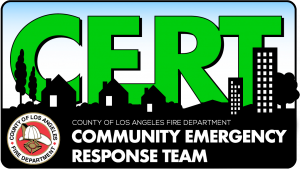
CERT Training is offered free of charge. Participants have no obligation or commitment to respond or act in the event of a disaster. The class curriculum for the training program consists of the following:
Unit 1 – DISASTER PREPAREDNESS
Introduction to disasters and the impact disasters have on infrastructures. This course covers the role of CERT volunteers.
Unit 2 – DISASTER FIRE SUPPRESSION
Fire chemistry and basic fire suppression; identifying and reducing potential fire hazards; firefighting resources and techniques, as well as a discussion on hazardous materials.
Unit 3 – DISASTER MEDICAL OPERATIONS 1
The principles of Triage and the treatment strategies for life-threatening conditions.
Unit 4 – DISASTER MEDICAL OPERATIONS 2
Head-to-toe patient assessments, establishing treatment areas, treatments for burns, lacerations, raptures, sprains, and other injuries. This is basic information, NOT a first-Aid class.
Unit 5 – LIGHT SEARCH AND RESCUE OPERATIONS
Search and Rescue priorities and resources; size-up techniques and rescuer safety, lifting, cribbing, and victim removal.
Unit 6 – DISASTER PSYCHOLOGY AND TEAM ORGANIZATION
The post disaster emotional environment, the Incident Command System, and decision-making and documentation.
Unit 7 – TERRORISM
Risk and threat analysis, types of terrorism weapons, and travel and terrorism.
Unit 8 – COURSE REVIEW AND SIMULATION
A review of your newly learned skills and either a hands-on drill simulation, or a table top exercise.
John R. Todd is a Registered Professional Forester in the State of California and he was employed as a forester by the Los Angeles County Fire Department from 1988 to 2012. In April 2012, John was promoted to the rank of deputy fire chief of the Prevention Services Bureau (PSB). The PSB is comprised of the Fire Prevention Division, the Forestry Division and the Health Hazardous Materials Division. Members of the Bureau serve the citizens of Los Angeles County by completing inspections and educating the community about the benefits of proper safety practices, completing building, sprinkler, and fire alarm plan checks, protecting natural resources, providing conservation education programs and advice to interested groups, using technology to assess weather, fuel moisture, and fire danger, and protecting public health and the environment from accidental releases and improper handling, storage, transportation, and disposal of hazardous materials and wastes.
John received a Bachelor of Science in Natural Resources Management from Cal Poly, San Luis Obispo in 1988. He has also completed many advanced courses in leadership, the Incident Command System, fire behavior, protection of resources, and urban search and rescue.
The Los Angeles County Fire Department Emergency Medical Services (EMS) Bureau was created in ____ ____, to address the growing EMS needs across the County. In total, EMS 9-1-1 calls comprise nearly 85 percent of the Department’s responses. The Department is committed to providing prompt, clinically skilled, and caring medical service to ensure positive outcomes for everyone, every time.
Saturday, June 1, 2019:
Wednesday, June 5, 2019:
Thursday, June 6, 2019:
Friday, June 7, 2019:
The dry, sunny climate and variable terrain of Southern California combine to create an environment where wildfires are a part of the natural ecosystem and an almost year-round occurrence. This ecosystem fosters a diverse fire-adapted community of plants and animals. Although human caused wildfires far outnumber naturally occurring wildfires within Los Angeles County, both have the potential to create situations where structures in the Wildland Urban Interface can be at risk. All vegetation will burn, even though irrigation has created a deceptively lush landscape of ornamental plants.
Following the loss of lives and structures during the 1993 wildfire season, the Los Angeles County Board of Supervisors created the Wildfire Safety Panel to offer recommendations that would help reduce the threat to life and property in areas prone to wildfires. One of the recommendations was to follow the findings of the Wildland Urban lnterface Task Force and another was to enforce the provisions of the Bates Bill. Jurisdictional Fire Departments were required to establish a set of guidelines and landscape criteria for all new construction in Fire Hazard Severity Zones. As a result, Fuel Modification Plans became a requirement within Los Angeles County beginning in 1996.
In the areas served by the County of Los Angeles Fire Department, all new construction, remodeling fifty percent or greater, construction of certain outbuildings and accessory structures over 120 square feet, parcel splits and subdivision/developments within areas designated as Fire Hazard Severity Zones will require a Fuel Modification Plan approval before the applicable land division, Conditional Use Permit, or Building Permit will be approved. The County of Los Angeles Fire Department Forestry Division’s Fuel Modification Unit is responsible for processing, reviewing, and approving these plans.
Cal Fire is responsible for the mapping and revisions to all Fire Hazard Severity Zones across the state. These zone designations establish minimum standards for building construction and exterior landscape features in an effort to mitigate the increasing losses from our cycle of wildfire vents. Cal Fire designates the Severity Zones for all State Responsibility Areas (SRAs). In Local Responsibility Areas (LRAs), the jurisdictional county or city determines the Severity Zones with approval from the state that are then adopted by local ordinance or city councils.
Santa Clarita
23757 Valencia Blvd
Valencia, CA 91355
(661) 286-8821
Lancaster
335-A East Ave K-6
Lancaster, CA 93535
(661) 949-6319
Palmdale Fire Prevention
38250 Sierra Highway
Palmdale, CA 93550
(661) 537-2901
Calabasas
26600 Agoura Road, Suite 110
Calabasas, CA 91302
(818) 880-0341
PUBLIC SAFETY AND FILM UNIT
14425 Olive View Drive
Sylmar, CA 91342
(818) 364-8240
